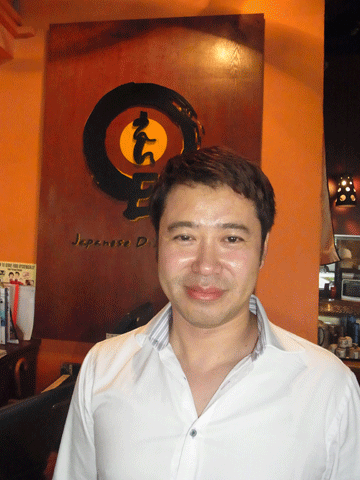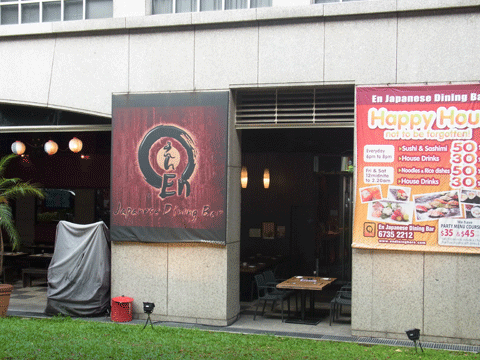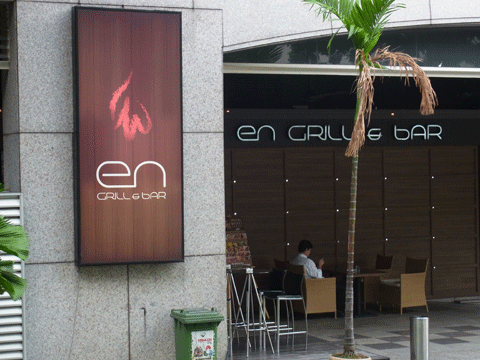September 1, 2012 05:29 PM
Bringing Okinawa culture to Singapore and Hong Kong. Method to penetrate culture of drinking while having dinner.
Mr.Raymond Ng En Holdings Pte Ltd, Director [Singapore]
By Masaaki Yasuda Interviewed on July 16, 2012
Singapore born, Japanese restaurant "En". Mr. Raymond Ng is currently managing total of 24 branches in Singapore, China, Indonesia and Malaysia. He born in Hong Kong, raised in Okinawa, started off En in year 2000. Interview with this Japanese food pioneer in Asia.


Mr.Raymond Ng
Raymond Ng has born in Hong Kong in 1966. Father is a tailor and immigrated into Okinawa when island made its reversion to work for tailoring U.S. army's suits and uniforms. Raymond has educated in Okinawa American School and got a job as an engineer after university study in U.S.
He had worked for American Elevator manufacturing company Otis for 3 years in Chiba, Japan branch and then moved into Singapore where Asia head quarter was. He had moved department of elevator manufacturing to new traffic system development.

En, 1st outlet.

en grill&Bar, next to En
Raymond said, "I have worked for Otis for 14 years. After recession of 9.11 in 2000, Asia head quarter has decided to dissolve and he had to return back to Japan. At the same timing, my brother and his wife who is from Okinawa was discussing about starting a restaurant. My brother was studying cooking before he joined his cloth trading job. His wife's father had an Okinawan and Japanese restaurant business back then. So I was happily committed and I thought it was the best timing. I was in charge for restaurant design which I was longing to be involved in, brother for cooking and his wife is for servicing as their roles."
"My brother couple had moved into Singapore and started the business in 2000. First branch was located at busy street of Mohamed Sultan Road near Robertson Quay. There is another En created in Okinawa city as well."
"First branch of En was very first Okinawan restaurant in Singapore. Mohamed Sultan Road used to be the hottest bar street until the recession to result to be much quieter than before. It was full of people queuing for entering bars and clubs. I have decided this place as a first Japanese restaurant in this street targeting at those night clubbers"
"It was an unexpected nightmare at the beginning. We have set our main target to locals however they have culture of dinner and drink at different places. Izakaya culture of drinking while having dinner was not adopted at the time. I tried to educate that Japanese culture, and started to have system of keeping the bottles for Japanese Sake and Shochu since they are familiar with keeping the bottles of whisky at the bars. That was our important turning point in our history."
"Our struggle continued for 6 month. I was expected too high by just relying on street population itself. There were not many Japanese owned restaurant at the time to learn from and had a hard time finding out what is initial Izakaya concept."
"We have charged our main target from locals to Japanese based in Singapore. Hired Japanese in the kitchen and shop front and advertised in Japanese newspapers. The effort came to a head and 80% of customer became Japanese. Japanese drinks while dinner and locals see, copy and finally adopt its culture I had been trying. Japanese and locals started to drink along. Local groups automatically order beers today."
Today, En has 35-40% of alcohol consumption which is competitive to Izakaya business in Japan. The reason of this increment was customer experience through watching other Japanese customer and its atmosphere. There is well balance of Japanese and locals in the restaurant at present.
"I did not change the initial concept. The key point was to let them understand or experience. Fortunately, I could gain a terrace seating to create beer bar atmosphere with smoking area to create better environment. It took almost a year for customer to start drinking at our restaurant. Since then we made terrace seating in every restaurant we have and alcohol sales went up."
The Hong Kong branch also has been successfully developing alcohol consumption. There is Okinawa Shochu bar "Rakuen" which serves Okinawan food in Tapas style.
"We have done Okinawan music show countless times collaborate with Sake manufacturer to penetrate the Okinawan Shochu of Awamori. We have done a huge dinner show with 1,000 visitors as well. It helped to gradually adopt the Okinawan food culture and drinking atmosphere is created."
"Today, we are most well-known Okinawan restaurant. New Okinawa restaurant who managed by Okinawan people stand at the counter but we are the very first pioneer. Restaurant needs to be also accompanied with Sushi and fusion Japanese, rather than just limit to Okinawan food strictly."
SARS and 2011 Tohoku earthquake affected and made us a hard time in our history.
"2011 Tohoku earthquake gave us a headache for 2 month. All Japanese restaurants were affected because of radiation issues to the food they supply. We were still on safe side as we have many of friend and cooked food and was not concentrating entirely on seafood. "
"I am planning to develop business into an inland area of China, Vietnam, Myanmar, Australia as well as western countries. The problem encounter is that we are family business. We only have 6 people in Singapore and 8 in Hong Kong. If we are planning to grow big, we need to make our company firmer and stronger with more employees."
Raymond says "If you want to start a new culture, you need to aggressively penetrate them by having events to experience." He taught Foodrink news and all Japanese firms moved into Asia about the importance of sending out message from ourselves.





